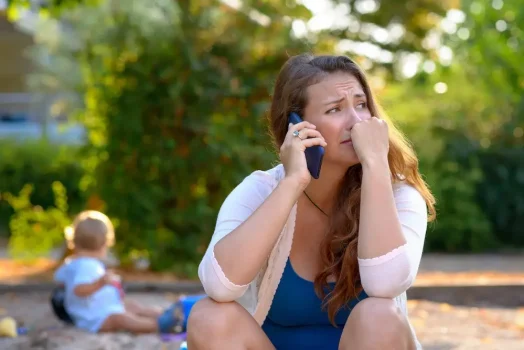Bipolar is misdiagnosed three times as much in women as it is in men. At Life Adjustment Team, we know how difficult living with bipolar disorder is, let alone living with it untreated. We want to assist you with knowing the signs of BP so you can move forward with living your best life.
Bipolar disorder is a form of mental illness that involves significant changes in mood, behavior, and certain other symptoms. Women can experience some distinctive characteristics of the condition, and its impact on them can differ from that of men. It is important to note that bipolar disorder may develop at any age and is equally common among men and women. Nevertheless, some differences do exist between the experiences.
Women are often afflicted by the condition later in life than men. Also, women experience longer periods of depressive symptoms than men. These symptoms may also follow different seasonal patterns compared to those that men experience. Additionally, if a person is mainly experiencing depressive symptoms, it may be much more difficult to diagnose their bipolar disorder.
There is also a possibility that women are at a higher risk of developing certain conditions that may accompany bipolar disorder, such as migraines, thyroid problems, obesity, and anxiety disorders. Additionally, it is crucial to note that women may experience symptoms similar to bipolar disorder during pregnancy, menopause, and menstruation.
Below, we look at how a female’s experience of bipolar disorder may differ from that of a male.
An Increased Risk of Depression
Studies have shown that bipolar II disorder is significantly more common in women than bipolar I disorder. Bipolar II involves symptoms of depression and hypomania (a less extreme form of mania), among other things.
Many women with bipolar disorder tend to have more depressive symptoms than those with manic symptoms. The likelihood that women with the condition will experience depression is twice as great as that of men. In addition, women with depression have a greater chance of experiencing psychosis. It is common for women suffering from bipolar disorder to receive an incorrect diagnosis of depression due to the dominance of depressive symptoms.
Differences in Symptom Patterns
When you have “mixed episodes” of bipolar disorder, your mood is somewhat high during episodes while experiencing some depressive symptoms at the same time. The frequency of mixed episodes is higher among women, according to some studies.
A phenomenon called rapid cycling, in which moods change rapidly in a short period of time may also be more common among females. Almost 30% of females with bipolar disorder reported rapid cycling in one study, compared with just over 16% of males with the disorder.
Seasonal Changes
The probability that women with bipolar disorder will need hospital treatment during spring and fall is higher than men, whose symptoms are likely to peak in spring. In addition to these findings, women are more likely to experience symptoms of depression in the winter and fall, compared to spring and summer for men.
Other Conditions
Interestingly, the DSM-5 reports that females with bipolar disorder are more likely to have a greater genetic risk of alcohol use disorder and a higher rate of lifetime eating disorders than males with the condition.
Bipolar disorder in females is also commonly accompanied by the following other conditions and factors affecting health:
- Impulse control disorder
- Borderline personality disorder
- Obesity
- A history of sexual and physical abuse
- Migraines
- Thyroid disease
Bipolar Disorder and Suicide Risk in Women
Women with bipolar disorder have a two to three times higher risk of attempting suicide compared to their male counterparts, according to statistics from 2015.
Earlier studies from 2014 reviewed both males and females with bipolar disorder regarding the risk of suicide. The researchers found the following predictors for suicide risk in women:
- The onset of psychiatric symptoms can begin as early as the early teens
- Having many mixed episodes throughout their lifetime or having symptoms of depression and manic symptoms at the same time
- “Social problems” relating to close relationships, including one’s family relationship
- The presence of a personality disorder in addition to a bipolar disorder
Social Factors and Prejudice
Research has shown that the social consequences of bipolar disorder, and the clinical consequences, can differ in females, confirming previous observations.
A review published in 2014 concluded that females are more likely than males to experience:
- Stigma and alienation
- Relationship changes
- A lack of self-determination and a loss of control, resulting in a sense of powerlessness
- Pressure to appear “normal” to avoid punishment such as losing custody of children
- A lack of understanding or empathy from healthcare providers and in the workplace
Furthermore, economic factors also played a role in how the study participants felt about their experience with bipolar disorder. People who reported having a safe place to live, as well as help with childcare and family responsibilities, tended to manage better than those without those necessities.
When circumstances such as poor living conditions, abuse, and a lack of support are present, this can increase the risk of severe symptoms of bipolar disorder and make managing the symptoms more difficult.
Menstruation, pregnancy, and menopause are also known to affect women with bipolar disorder differently to varying degrees.
Getting Help
Outpatient treatment options like ours at LAT: Intensive Outpatient Program significantly improve outcomes for people with bipolar disorder, regardless of sex or gender. We bring personalized, one-to-one support to you where you are to meet your unique healthcare needs. In addition, our hands-on group and individual Cognitive and Dialectical Behavior Therapy sessions help clients find ways to accept themselves, feel safe, and manage their emotions to help regulate potentially harmful or destructive behaviors.








